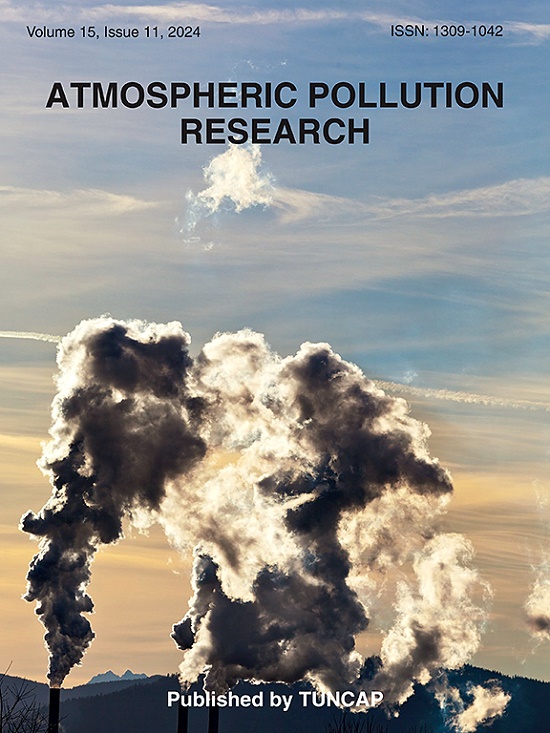气象变量和人类活动对关中平原降水化学的影响
IF 3.9
3区 环境科学与生态学
Q2 ENVIRONMENTAL SCIENCES
引用次数: 0
摘要
降水化学可以反映人为和自然来源对空气质量的影响,并提供对地球表面和大气之间物质循环的见解。以关中平原农业生态保护重镇渭南为研究对象,探讨渭南降水化学特征与气象环境因子的关系。采用化学计量学分析、相关分析、正矩阵分解(PMF)模型和逆向轨迹模型对渭南市2021 - 2022年降水样品(n = 291)进行化学成分分析。结果表明,降水中的主要离子为Ca2+、NH4+、SO42−和NO3−。受降水量、湿度、PM2.5和PM10变化的影响,大部分离子浓度冬季偏高,夏季偏低。PMF分析确定了降水中的6种离子来源,包括地壳来源(24.9%)、二次形成(20.7%)、垃圾焚烧(16%)、海洋来源(15%)、工业排放(11.8%)和生物质燃烧(11.5%)。反轨迹分析表明,水汽输送具有明显的季节变化特征,主要受西风、季风和区域环流的影响。西风环流主要通过向渭南输送粉尘和人为污染物来影响离子浓度。季风环流携带大量水汽,对降水贡献最大(54.38%)。研究揭示了自然因素、人类活动和水汽来源对西北地区降水化学的影响,为西北地区大气质量管理和污染控制提供决策支持。本文章由计算机程序翻译,如有差异,请以英文原文为准。

Influence of meteorological variables and human activities on precipitation chemistry in the Guanzhong Plain, Northwest China
Precipitation chemistry can reflect the impacts of both anthropogenic and natural sources on air quality and provide insights into material cycles between the Earth's surface and atmosphere. We explored the chemical characteristics of precipitation in relation to meteorological and environmental factors in Weinan, a key hub for agriculture and ecological protection on the Guanzhong Plain in Northwest China. Precipitation samples (n = 291) collected in Weinan from 2021 to 2022 were analyzed for their chemical compositions using chemometric analysis, correlation analysis, the positive matrix factorization (PMF) model, and the backward trajectory model. The findings revealed that the primary ions in the precipitation were Ca2+, NH4+, SO42− and NO3−. The concentrations of most ions were higher in winter and lower in summer due to changes in precipitation amount, humidity, PM2.5 and PM10. The PMF analysis identified six ion sources in precipitation, including crustal sources (24.9 %), secondary formation (20.7 %), waste incineration (16 %), marine sources (15 %), industrial emissions (11.8 %), and biomass burning (11.5 %). The backward trajectory analysis showed that water vapor transport varies seasonally and is primarily influenced by westerly, monsoonal, and regional circulations. The westerly circulation predominantly affects ion concentrations by transporting dust and anthropogenic pollutants to Weinan. The monsoonal circulation carries large amounts of water vapor and contributes the most to precipitation (54.38 %). This study reveals the impacts of natural factors, human activities, and water vapor sources on precipitation chemistry and offers decision support for air quality management and pollution control in Northwest China.
求助全文
通过发布文献求助,成功后即可免费获取论文全文。
去求助
来源期刊

Atmospheric Pollution Research
ENVIRONMENTAL SCIENCES-
CiteScore
8.30
自引率
6.70%
发文量
256
审稿时长
36 days
期刊介绍:
Atmospheric Pollution Research (APR) is an international journal designed for the publication of articles on air pollution. Papers should present novel experimental results, theory and modeling of air pollution on local, regional, or global scales. Areas covered are research on inorganic, organic, and persistent organic air pollutants, air quality monitoring, air quality management, atmospheric dispersion and transport, air-surface (soil, water, and vegetation) exchange of pollutants, dry and wet deposition, indoor air quality, exposure assessment, health effects, satellite measurements, natural emissions, atmospheric chemistry, greenhouse gases, and effects on climate change.
 求助内容:
求助内容: 应助结果提醒方式:
应助结果提醒方式:


